Employee Turnover Analysis & Control in the Hilton Hotel Industry
VerifiedAdded on 2020/10/05
|26
|5628
|171
Project
AI Summary
This research project examines employee turnover within the hotel industry, specifically focusing on Hilton Hotel as a case study. The project begins with an introduction that outlines the background, rationale, aims, objectives, research questions, and significance of the study, including the dissertation structure. Chapter 2 provides a comprehensive literature review, exploring the concept of employee turnover, its impact on the hotel industry, and methods for measuring and controlling it. The literature review covers various aspects, such as voluntary and involuntary turnover, and the importance of employee satisfaction. Chapter 3 focuses on the research methodology, while Chapter 4 presents the data collection methods and findings. The final chapter, Chapter 5, offers conclusions and recommendations for Hilton Hotel, suggesting strategies to improve employee retention and overall operational performance. The project highlights the importance of creating a positive workplace culture, investing in leadership, and providing benefits to employees to mitigate turnover rates and enhance service quality.

RESEARCH PROJECT
Paraphrase This Document
Need a fresh take? Get an instant paraphrase of this document with our AI Paraphraser
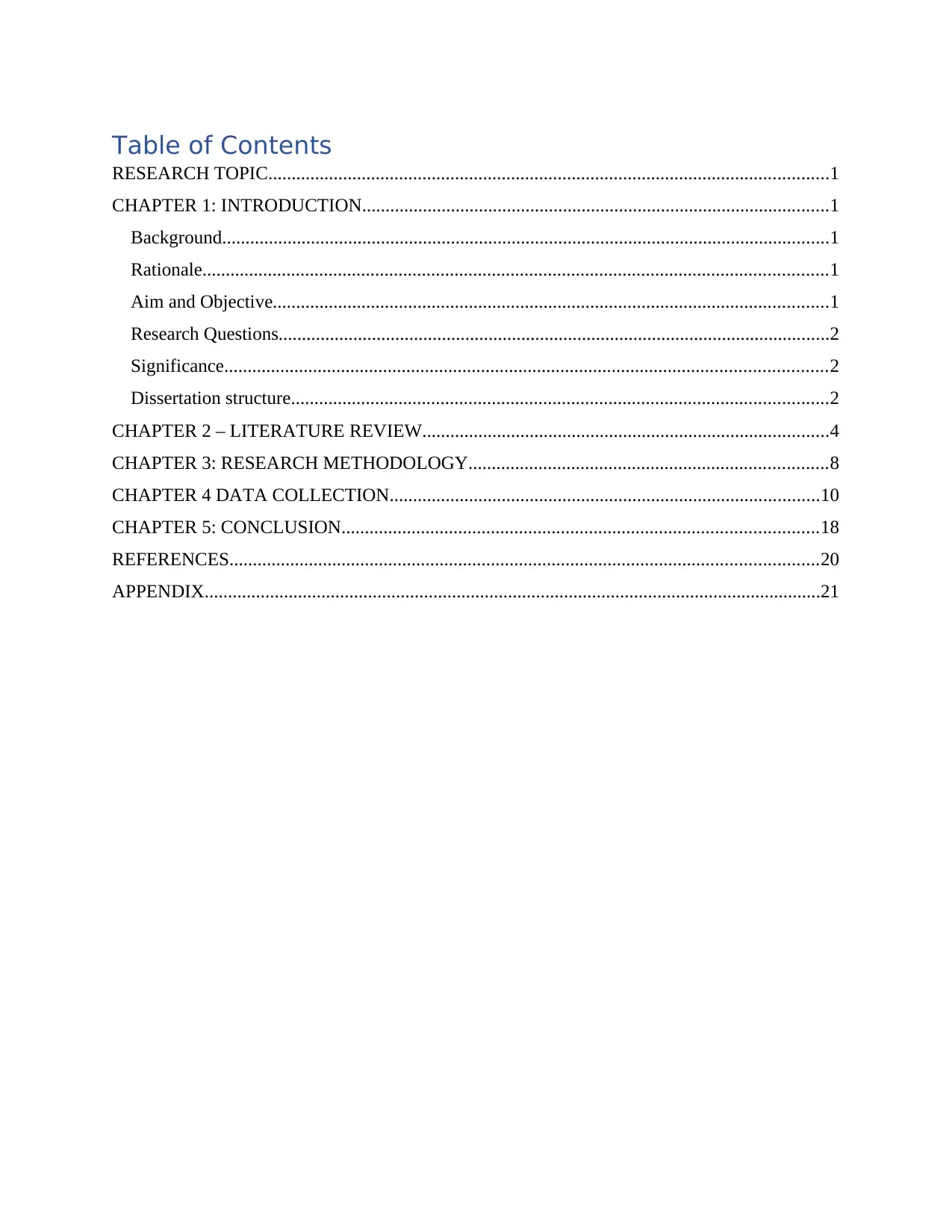
Table of Contents
RESEARCH TOPIC........................................................................................................................1
CHAPTER 1: INTRODUCTION....................................................................................................1
Background..................................................................................................................................1
Rationale......................................................................................................................................1
Aim and Objective.......................................................................................................................1
Research Questions......................................................................................................................2
Significance.................................................................................................................................2
Dissertation structure...................................................................................................................2
CHAPTER 2 – LITERATURE REVIEW.......................................................................................4
CHAPTER 3: RESEARCH METHODOLOGY.............................................................................8
CHAPTER 4 DATA COLLECTION............................................................................................10
CHAPTER 5: CONCLUSION......................................................................................................18
REFERENCES..............................................................................................................................20
APPENDIX....................................................................................................................................21
RESEARCH TOPIC........................................................................................................................1
CHAPTER 1: INTRODUCTION....................................................................................................1
Background..................................................................................................................................1
Rationale......................................................................................................................................1
Aim and Objective.......................................................................................................................1
Research Questions......................................................................................................................2
Significance.................................................................................................................................2
Dissertation structure...................................................................................................................2
CHAPTER 2 – LITERATURE REVIEW.......................................................................................4
CHAPTER 3: RESEARCH METHODOLOGY.............................................................................8
CHAPTER 4 DATA COLLECTION............................................................................................10
CHAPTER 5: CONCLUSION......................................................................................................18
REFERENCES..............................................................................................................................20
APPENDIX....................................................................................................................................21
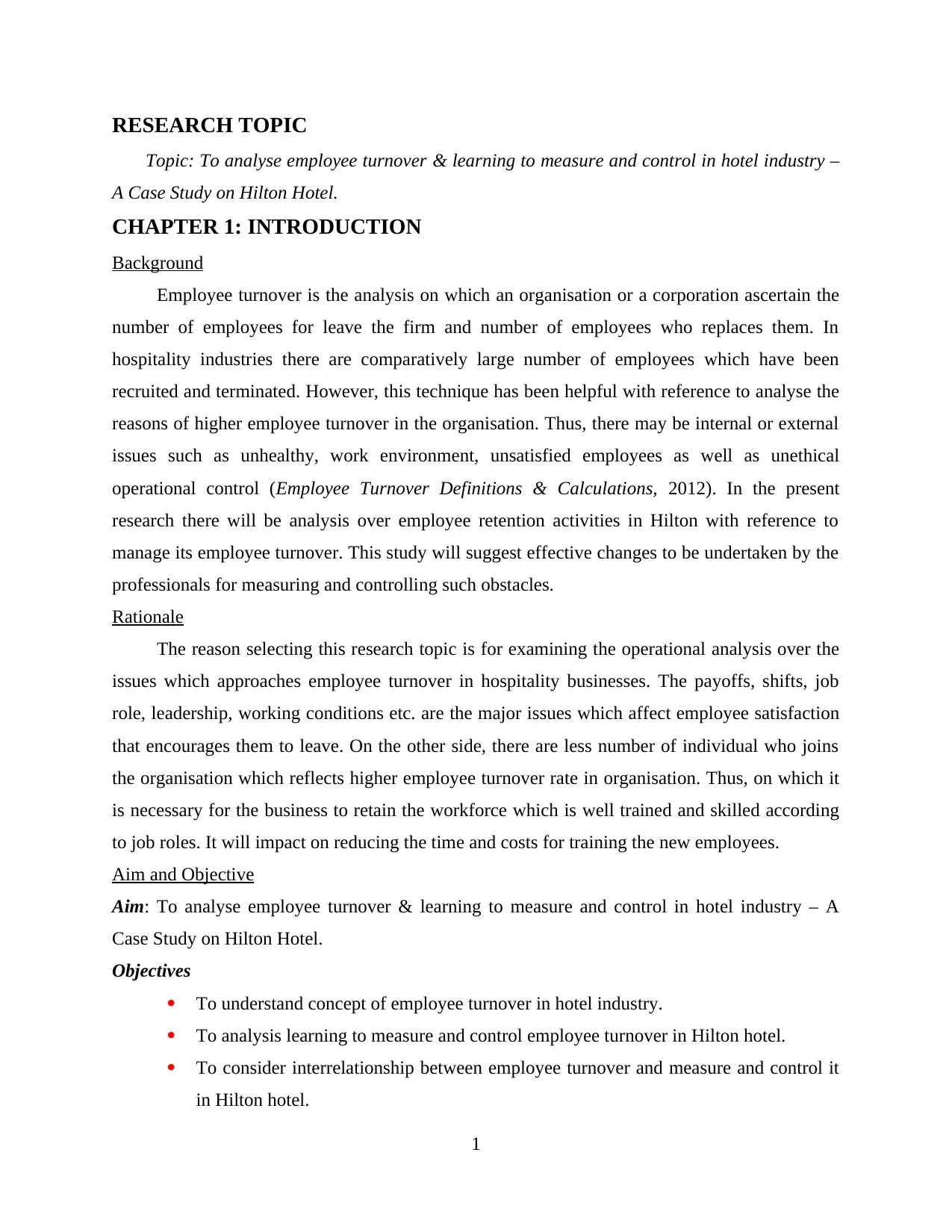
RESEARCH TOPIC
Topic: To analyse employee turnover & learning to measure and control in hotel industry –
A Case Study on Hilton Hotel.
CHAPTER 1: INTRODUCTION
Background
Employee turnover is the analysis on which an organisation or a corporation ascertain the
number of employees for leave the firm and number of employees who replaces them. In
hospitality industries there are comparatively large number of employees which have been
recruited and terminated. However, this technique has been helpful with reference to analyse the
reasons of higher employee turnover in the organisation. Thus, there may be internal or external
issues such as unhealthy, work environment, unsatisfied employees as well as unethical
operational control (Employee Turnover Definitions & Calculations, 2012). In the present
research there will be analysis over employee retention activities in Hilton with reference to
manage its employee turnover. This study will suggest effective changes to be undertaken by the
professionals for measuring and controlling such obstacles.
Rationale
The reason selecting this research topic is for examining the operational analysis over the
issues which approaches employee turnover in hospitality businesses. The payoffs, shifts, job
role, leadership, working conditions etc. are the major issues which affect employee satisfaction
that encourages them to leave. On the other side, there are less number of individual who joins
the organisation which reflects higher employee turnover rate in organisation. Thus, on which it
is necessary for the business to retain the workforce which is well trained and skilled according
to job roles. It will impact on reducing the time and costs for training the new employees.
Aim and Objective
Aim: To analyse employee turnover & learning to measure and control in hotel industry – A
Case Study on Hilton Hotel.
Objectives
To understand concept of employee turnover in hotel industry.
To analysis learning to measure and control employee turnover in Hilton hotel.
To consider interrelationship between employee turnover and measure and control it
in Hilton hotel.
1
Topic: To analyse employee turnover & learning to measure and control in hotel industry –
A Case Study on Hilton Hotel.
CHAPTER 1: INTRODUCTION
Background
Employee turnover is the analysis on which an organisation or a corporation ascertain the
number of employees for leave the firm and number of employees who replaces them. In
hospitality industries there are comparatively large number of employees which have been
recruited and terminated. However, this technique has been helpful with reference to analyse the
reasons of higher employee turnover in the organisation. Thus, there may be internal or external
issues such as unhealthy, work environment, unsatisfied employees as well as unethical
operational control (Employee Turnover Definitions & Calculations, 2012). In the present
research there will be analysis over employee retention activities in Hilton with reference to
manage its employee turnover. This study will suggest effective changes to be undertaken by the
professionals for measuring and controlling such obstacles.
Rationale
The reason selecting this research topic is for examining the operational analysis over the
issues which approaches employee turnover in hospitality businesses. The payoffs, shifts, job
role, leadership, working conditions etc. are the major issues which affect employee satisfaction
that encourages them to leave. On the other side, there are less number of individual who joins
the organisation which reflects higher employee turnover rate in organisation. Thus, on which it
is necessary for the business to retain the workforce which is well trained and skilled according
to job roles. It will impact on reducing the time and costs for training the new employees.
Aim and Objective
Aim: To analyse employee turnover & learning to measure and control in hotel industry – A
Case Study on Hilton Hotel.
Objectives
To understand concept of employee turnover in hotel industry.
To analysis learning to measure and control employee turnover in Hilton hotel.
To consider interrelationship between employee turnover and measure and control it
in Hilton hotel.
1
⊘ This is a preview!⊘
Do you want full access?
Subscribe today to unlock all pages.

Trusted by 1+ million students worldwide

To recommend ways through employee turnover activities can be reduces and
effectiveness of Hilton hotel will be successfully developed in the country.
Research Questions
What do you understand concept of employee turnover in hotel industry?
How to analysis learning to measure and control employee turnover in Hilton hotel?
How to consider interrelationship between employee turnover and measure and control it
in Hilton hotel?
Significance
Study will be effective with reference to communicate the best measures and tactics to be
considered by the professionals with reference to manage employee satisfaction in hospitality
industry. Evaluating the reasons which affect employee satisfaction as well as negative working
environment would be effective in developing the best motivating analysis. This research will be
suggestive to the managers at Hilton hotel on which they would become able to take corrective
actions to improve employee retention rate. Measuring the employee turnover will be beneficial
in relation to enhance operational performance as well as productivity of industry.
Dissertation structure
By considering the importance of research techniques as well as structure which are to be
followed by researchers have been analysed as per below listed structure such as:
Chapter 1 Introduction: In this part of the study there have been
development of aim and objectives through
which researcher will amend the process of
research. Along with this, it will include an
introductory analysis over the research
operations.
Chapter 2 Literature review: There has been analysis over various theories
and models regarding employee turnover.
Thus, the influences of view points by various
author will be debated in this part.
Chapter 3 Research methodology: In this chapter there have been determination of
the effective framework to be considered by the
researcher to examine appropriate outcomes.
2
effectiveness of Hilton hotel will be successfully developed in the country.
Research Questions
What do you understand concept of employee turnover in hotel industry?
How to analysis learning to measure and control employee turnover in Hilton hotel?
How to consider interrelationship between employee turnover and measure and control it
in Hilton hotel?
Significance
Study will be effective with reference to communicate the best measures and tactics to be
considered by the professionals with reference to manage employee satisfaction in hospitality
industry. Evaluating the reasons which affect employee satisfaction as well as negative working
environment would be effective in developing the best motivating analysis. This research will be
suggestive to the managers at Hilton hotel on which they would become able to take corrective
actions to improve employee retention rate. Measuring the employee turnover will be beneficial
in relation to enhance operational performance as well as productivity of industry.
Dissertation structure
By considering the importance of research techniques as well as structure which are to be
followed by researchers have been analysed as per below listed structure such as:
Chapter 1 Introduction: In this part of the study there have been
development of aim and objectives through
which researcher will amend the process of
research. Along with this, it will include an
introductory analysis over the research
operations.
Chapter 2 Literature review: There has been analysis over various theories
and models regarding employee turnover.
Thus, the influences of view points by various
author will be debated in this part.
Chapter 3 Research methodology: In this chapter there have been determination of
the effective framework to be considered by the
researcher to examine appropriate outcomes.
2
Paraphrase This Document
Need a fresh take? Get an instant paraphrase of this document with our AI Paraphraser
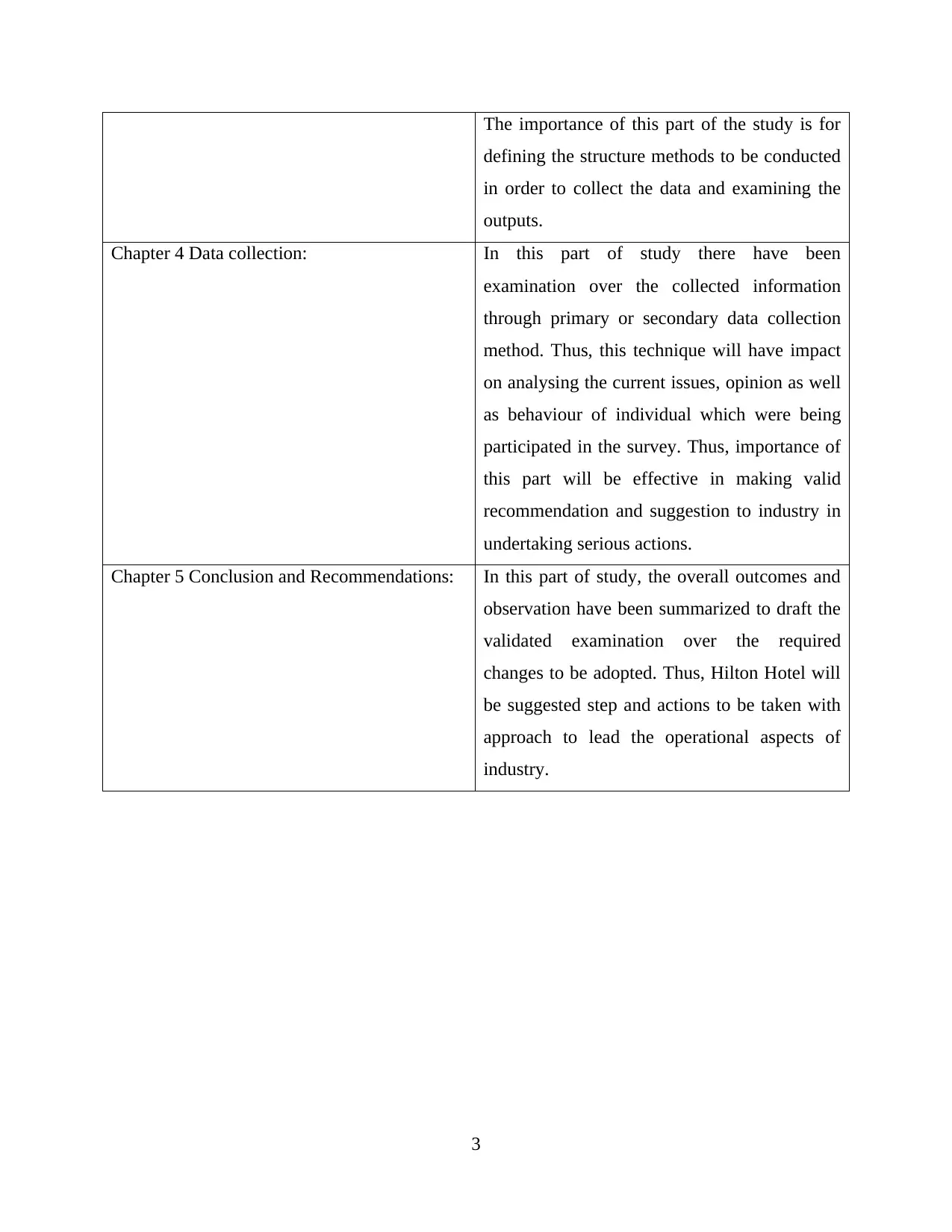
The importance of this part of the study is for
defining the structure methods to be conducted
in order to collect the data and examining the
outputs.
Chapter 4 Data collection: In this part of study there have been
examination over the collected information
through primary or secondary data collection
method. Thus, this technique will have impact
on analysing the current issues, opinion as well
as behaviour of individual which were being
participated in the survey. Thus, importance of
this part will be effective in making valid
recommendation and suggestion to industry in
undertaking serious actions.
Chapter 5 Conclusion and Recommendations: In this part of study, the overall outcomes and
observation have been summarized to draft the
validated examination over the required
changes to be adopted. Thus, Hilton Hotel will
be suggested step and actions to be taken with
approach to lead the operational aspects of
industry.
3
defining the structure methods to be conducted
in order to collect the data and examining the
outputs.
Chapter 4 Data collection: In this part of study there have been
examination over the collected information
through primary or secondary data collection
method. Thus, this technique will have impact
on analysing the current issues, opinion as well
as behaviour of individual which were being
participated in the survey. Thus, importance of
this part will be effective in making valid
recommendation and suggestion to industry in
undertaking serious actions.
Chapter 5 Conclusion and Recommendations: In this part of study, the overall outcomes and
observation have been summarized to draft the
validated examination over the required
changes to be adopted. Thus, Hilton Hotel will
be suggested step and actions to be taken with
approach to lead the operational aspects of
industry.
3
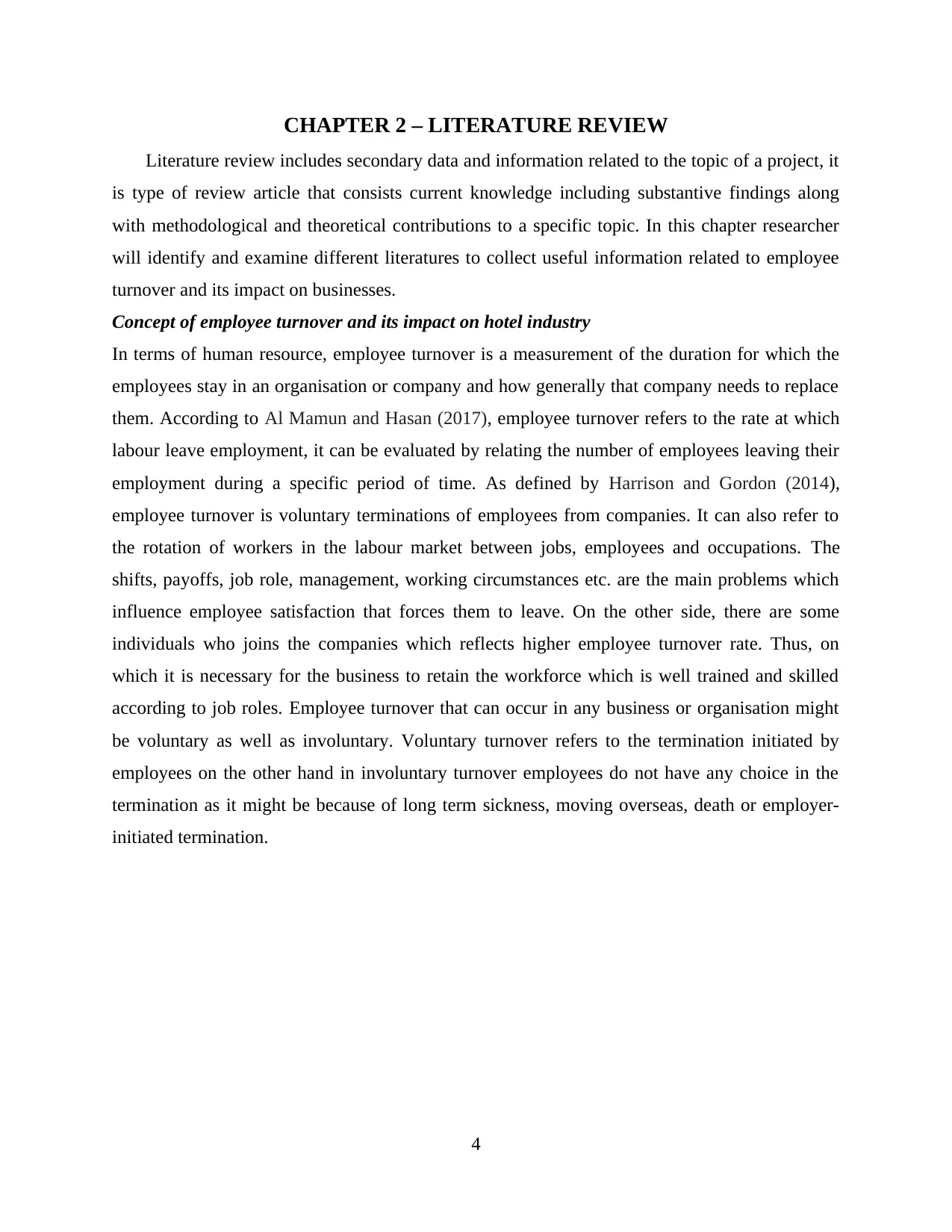
CHAPTER 2 – LITERATURE REVIEW
Literature review includes secondary data and information related to the topic of a project, it
is type of review article that consists current knowledge including substantive findings along
with methodological and theoretical contributions to a specific topic. In this chapter researcher
will identify and examine different literatures to collect useful information related to employee
turnover and its impact on businesses.
Concept of employee turnover and its impact on hotel industry
In terms of human resource, employee turnover is a measurement of the duration for which the
employees stay in an organisation or company and how generally that company needs to replace
them. According to Al Mamun and Hasan (2017), employee turnover refers to the rate at which
labour leave employment, it can be evaluated by relating the number of employees leaving their
employment during a specific period of time. As defined by Harrison and Gordon (2014),
employee turnover is voluntary terminations of employees from companies. It can also refer to
the rotation of workers in the labour market between jobs, employees and occupations. The
shifts, payoffs, job role, management, working circumstances etc. are the main problems which
influence employee satisfaction that forces them to leave. On the other side, there are some
individuals who joins the companies which reflects higher employee turnover rate. Thus, on
which it is necessary for the business to retain the workforce which is well trained and skilled
according to job roles. Employee turnover that can occur in any business or organisation might
be voluntary as well as involuntary. Voluntary turnover refers to the termination initiated by
employees on the other hand in involuntary turnover employees do not have any choice in the
termination as it might be because of long term sickness, moving overseas, death or employer-
initiated termination.
4
Literature review includes secondary data and information related to the topic of a project, it
is type of review article that consists current knowledge including substantive findings along
with methodological and theoretical contributions to a specific topic. In this chapter researcher
will identify and examine different literatures to collect useful information related to employee
turnover and its impact on businesses.
Concept of employee turnover and its impact on hotel industry
In terms of human resource, employee turnover is a measurement of the duration for which the
employees stay in an organisation or company and how generally that company needs to replace
them. According to Al Mamun and Hasan (2017), employee turnover refers to the rate at which
labour leave employment, it can be evaluated by relating the number of employees leaving their
employment during a specific period of time. As defined by Harrison and Gordon (2014),
employee turnover is voluntary terminations of employees from companies. It can also refer to
the rotation of workers in the labour market between jobs, employees and occupations. The
shifts, payoffs, job role, management, working circumstances etc. are the main problems which
influence employee satisfaction that forces them to leave. On the other side, there are some
individuals who joins the companies which reflects higher employee turnover rate. Thus, on
which it is necessary for the business to retain the workforce which is well trained and skilled
according to job roles. Employee turnover that can occur in any business or organisation might
be voluntary as well as involuntary. Voluntary turnover refers to the termination initiated by
employees on the other hand in involuntary turnover employees do not have any choice in the
termination as it might be because of long term sickness, moving overseas, death or employer-
initiated termination.
4
⊘ This is a preview!⊘
Do you want full access?
Subscribe today to unlock all pages.

Trusted by 1+ million students worldwide

Figure 1: Framework of staff turnover
(Source: Framework of staff turnover, 2018)
According to Katsikea, Theodosiou and Morgan (2015), Turnover is one of the biggest issues for
hotel industry and businesses. Though the rates of turnover of hourly employees are high,
turnover rates among waiters are more challenging due to the disruption raised by their exits. The
hospitality industry highly depends upon motivation and performance of its employees to
achieve success. Hotel businesses is very labour intensive, the average rate of turnover for hourly
employees in hotels is measured to be between 60 to 300%. Employee turnover negatively affect
the uniformity in the quality of services provided by the hotels. According to Kim (2014), direct
and indirect cost related to turnover ratio directly influences organisation’s profitability. On the
other hand, it also helps to improve quality of services and performance of the hotels.
Measuring and controlling employee’s turnover
Impact of employee or labour turnover depends upon the rate of labour turnover, it is not
possible to eliminate it completely. Normal rate of employee turnover due to death, retirement
etc can be observed in each and every company, it does not have much negative impact on the
organisation’s performance. But high turnover ratio may lead to various issues in the business
performance and functions. All organisation needs to have a specific rate or level of employee
turnover which is considered to be normal to that trade and industry. The companies need to take
5
(Source: Framework of staff turnover, 2018)
According to Katsikea, Theodosiou and Morgan (2015), Turnover is one of the biggest issues for
hotel industry and businesses. Though the rates of turnover of hourly employees are high,
turnover rates among waiters are more challenging due to the disruption raised by their exits. The
hospitality industry highly depends upon motivation and performance of its employees to
achieve success. Hotel businesses is very labour intensive, the average rate of turnover for hourly
employees in hotels is measured to be between 60 to 300%. Employee turnover negatively affect
the uniformity in the quality of services provided by the hotels. According to Kim (2014), direct
and indirect cost related to turnover ratio directly influences organisation’s profitability. On the
other hand, it also helps to improve quality of services and performance of the hotels.
Measuring and controlling employee’s turnover
Impact of employee or labour turnover depends upon the rate of labour turnover, it is not
possible to eliminate it completely. Normal rate of employee turnover due to death, retirement
etc can be observed in each and every company, it does not have much negative impact on the
organisation’s performance. But high turnover ratio may lead to various issues in the business
performance and functions. All organisation needs to have a specific rate or level of employee
turnover which is considered to be normal to that trade and industry. The companies need to take
5
Paraphrase This Document
Need a fresh take? Get an instant paraphrase of this document with our AI Paraphraser
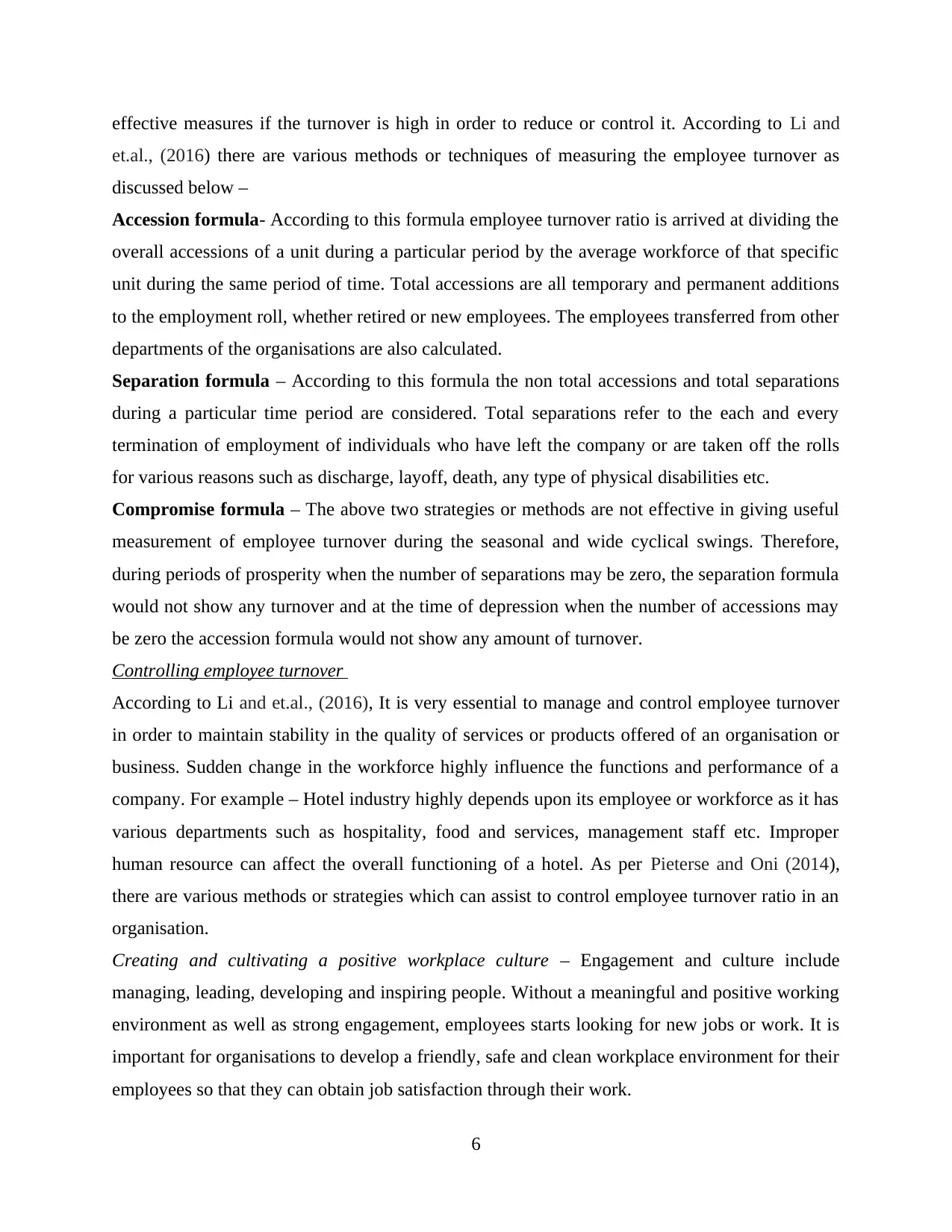
effective measures if the turnover is high in order to reduce or control it. According to Li and
et.al., (2016) there are various methods or techniques of measuring the employee turnover as
discussed below –
Accession formula- According to this formula employee turnover ratio is arrived at dividing the
overall accessions of a unit during a particular period by the average workforce of that specific
unit during the same period of time. Total accessions are all temporary and permanent additions
to the employment roll, whether retired or new employees. The employees transferred from other
departments of the organisations are also calculated.
Separation formula – According to this formula the non total accessions and total separations
during a particular time period are considered. Total separations refer to the each and every
termination of employment of individuals who have left the company or are taken off the rolls
for various reasons such as discharge, layoff, death, any type of physical disabilities etc.
Compromise formula – The above two strategies or methods are not effective in giving useful
measurement of employee turnover during the seasonal and wide cyclical swings. Therefore,
during periods of prosperity when the number of separations may be zero, the separation formula
would not show any turnover and at the time of depression when the number of accessions may
be zero the accession formula would not show any amount of turnover.
Controlling employee turnover
According to Li and et.al., (2016), It is very essential to manage and control employee turnover
in order to maintain stability in the quality of services or products offered of an organisation or
business. Sudden change in the workforce highly influence the functions and performance of a
company. For example – Hotel industry highly depends upon its employee or workforce as it has
various departments such as hospitality, food and services, management staff etc. Improper
human resource can affect the overall functioning of a hotel. As per Pieterse and Oni (2014),
there are various methods or strategies which can assist to control employee turnover ratio in an
organisation.
Creating and cultivating a positive workplace culture – Engagement and culture include
managing, leading, developing and inspiring people. Without a meaningful and positive working
environment as well as strong engagement, employees starts looking for new jobs or work. It is
important for organisations to develop a friendly, safe and clean workplace environment for their
employees so that they can obtain job satisfaction through their work.
6
et.al., (2016) there are various methods or techniques of measuring the employee turnover as
discussed below –
Accession formula- According to this formula employee turnover ratio is arrived at dividing the
overall accessions of a unit during a particular period by the average workforce of that specific
unit during the same period of time. Total accessions are all temporary and permanent additions
to the employment roll, whether retired or new employees. The employees transferred from other
departments of the organisations are also calculated.
Separation formula – According to this formula the non total accessions and total separations
during a particular time period are considered. Total separations refer to the each and every
termination of employment of individuals who have left the company or are taken off the rolls
for various reasons such as discharge, layoff, death, any type of physical disabilities etc.
Compromise formula – The above two strategies or methods are not effective in giving useful
measurement of employee turnover during the seasonal and wide cyclical swings. Therefore,
during periods of prosperity when the number of separations may be zero, the separation formula
would not show any turnover and at the time of depression when the number of accessions may
be zero the accession formula would not show any amount of turnover.
Controlling employee turnover
According to Li and et.al., (2016), It is very essential to manage and control employee turnover
in order to maintain stability in the quality of services or products offered of an organisation or
business. Sudden change in the workforce highly influence the functions and performance of a
company. For example – Hotel industry highly depends upon its employee or workforce as it has
various departments such as hospitality, food and services, management staff etc. Improper
human resource can affect the overall functioning of a hotel. As per Pieterse and Oni (2014),
there are various methods or strategies which can assist to control employee turnover ratio in an
organisation.
Creating and cultivating a positive workplace culture – Engagement and culture include
managing, leading, developing and inspiring people. Without a meaningful and positive working
environment as well as strong engagement, employees starts looking for new jobs or work. It is
important for organisations to develop a friendly, safe and clean workplace environment for their
employees so that they can obtain job satisfaction through their work.
6

Evaluating and investing in leaders – According to Pieterse and Oni (2014), the statement
“people don not leave companies they leave leaders” is not always true. But an organisation
should take care that they do not motivate an employee to hunt for a new job by leaving an inept
manager to manage or lead. Recruiting and promoting the right individuals is very important and
it is also essential to remember that even good managers need great managers. Employees at
management level or positions also require opportunities for learning and new challenges. It is
essential for the organisations to invent in the leader by making sure that they are receiving
management training, even if they are experienced and been in the management for a long period
of time.
Make it hard to walk away – As per Harrison and Gordan (2014), it is also significant for
organisations to focus on providing benefits to the employees as it is the most influencing thing
which can help them to stay in the company. Companies should try to provide attractive salary
packages and other benefits to their employees in order to hold them in the organisation.
Providing incentives, bonuses, safety and training can motivate employees to stay in the
organisation and improve their performance.
Improving recruitment strategies – Hiring the right candidates for the job and the working
environment is necessary. According to Shuck and et.al., (2014), the recruitment strategy or
method utilised for brining new talent in the organisation should be very effective and unique.
This is due to the reason that it is very essential for an organisation to hire the most qualified
individual for a particular job or position.
Improve office communications – According to Pieterse and Oni (2014), weak communications
in an organisation can lead to confusion and frustrations. Employees do not like to be frustrated
and confused, it is a major reason for which they leave an organisation or company. It is
important for a company to audit their internal communication methods and strategies as well as
improve on any weaknesses identified with priority.
Training and staff development – It’s also important to provide effective training to the
employees and conduct staff development programs for them. If employees are given
opportunities to develop and improve their skills or knowledge it can improve their level of job
satisfaction. In order to motivate employees and hold them within the organisation it is very
essential to focus on their development needs. It helps to manage and control the employee.
7
“people don not leave companies they leave leaders” is not always true. But an organisation
should take care that they do not motivate an employee to hunt for a new job by leaving an inept
manager to manage or lead. Recruiting and promoting the right individuals is very important and
it is also essential to remember that even good managers need great managers. Employees at
management level or positions also require opportunities for learning and new challenges. It is
essential for the organisations to invent in the leader by making sure that they are receiving
management training, even if they are experienced and been in the management for a long period
of time.
Make it hard to walk away – As per Harrison and Gordan (2014), it is also significant for
organisations to focus on providing benefits to the employees as it is the most influencing thing
which can help them to stay in the company. Companies should try to provide attractive salary
packages and other benefits to their employees in order to hold them in the organisation.
Providing incentives, bonuses, safety and training can motivate employees to stay in the
organisation and improve their performance.
Improving recruitment strategies – Hiring the right candidates for the job and the working
environment is necessary. According to Shuck and et.al., (2014), the recruitment strategy or
method utilised for brining new talent in the organisation should be very effective and unique.
This is due to the reason that it is very essential for an organisation to hire the most qualified
individual for a particular job or position.
Improve office communications – According to Pieterse and Oni (2014), weak communications
in an organisation can lead to confusion and frustrations. Employees do not like to be frustrated
and confused, it is a major reason for which they leave an organisation or company. It is
important for a company to audit their internal communication methods and strategies as well as
improve on any weaknesses identified with priority.
Training and staff development – It’s also important to provide effective training to the
employees and conduct staff development programs for them. If employees are given
opportunities to develop and improve their skills or knowledge it can improve their level of job
satisfaction. In order to motivate employees and hold them within the organisation it is very
essential to focus on their development needs. It helps to manage and control the employee.
7
⊘ This is a preview!⊘
Do you want full access?
Subscribe today to unlock all pages.

Trusted by 1+ million students worldwide
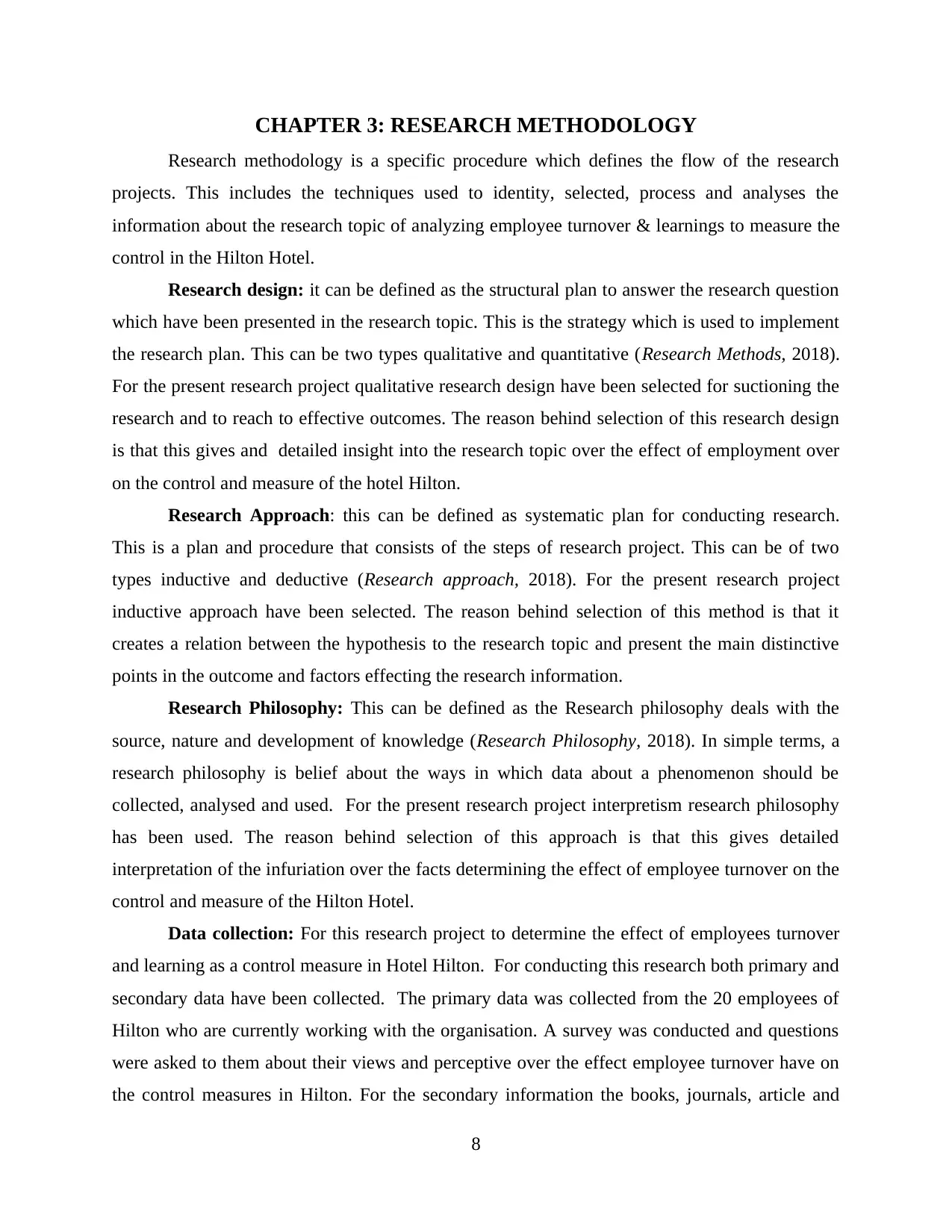
CHAPTER 3: RESEARCH METHODOLOGY
Research methodology is a specific procedure which defines the flow of the research
projects. This includes the techniques used to identity, selected, process and analyses the
information about the research topic of analyzing employee turnover & learnings to measure the
control in the Hilton Hotel.
Research design: it can be defined as the structural plan to answer the research question
which have been presented in the research topic. This is the strategy which is used to implement
the research plan. This can be two types qualitative and quantitative (Research Methods, 2018).
For the present research project qualitative research design have been selected for suctioning the
research and to reach to effective outcomes. The reason behind selection of this research design
is that this gives and detailed insight into the research topic over the effect of employment over
on the control and measure of the hotel Hilton.
Research Approach: this can be defined as systematic plan for conducting research.
This is a plan and procedure that consists of the steps of research project. This can be of two
types inductive and deductive (Research approach, 2018). For the present research project
inductive approach have been selected. The reason behind selection of this method is that it
creates a relation between the hypothesis to the research topic and present the main distinctive
points in the outcome and factors effecting the research information.
Research Philosophy: This can be defined as the Research philosophy deals with the
source, nature and development of knowledge (Research Philosophy, 2018). In simple terms, a
research philosophy is belief about the ways in which data about a phenomenon should be
collected, analysed and used. For the present research project interpretism research philosophy
has been used. The reason behind selection of this approach is that this gives detailed
interpretation of the infuriation over the facts determining the effect of employee turnover on the
control and measure of the Hilton Hotel.
Data collection: For this research project to determine the effect of employees turnover
and learning as a control measure in Hotel Hilton. For conducting this research both primary and
secondary data have been collected. The primary data was collected from the 20 employees of
Hilton who are currently working with the organisation. A survey was conducted and questions
were asked to them about their views and perceptive over the effect employee turnover have on
the control measures in Hilton. For the secondary information the books, journals, article and
8
Research methodology is a specific procedure which defines the flow of the research
projects. This includes the techniques used to identity, selected, process and analyses the
information about the research topic of analyzing employee turnover & learnings to measure the
control in the Hilton Hotel.
Research design: it can be defined as the structural plan to answer the research question
which have been presented in the research topic. This is the strategy which is used to implement
the research plan. This can be two types qualitative and quantitative (Research Methods, 2018).
For the present research project qualitative research design have been selected for suctioning the
research and to reach to effective outcomes. The reason behind selection of this research design
is that this gives and detailed insight into the research topic over the effect of employment over
on the control and measure of the hotel Hilton.
Research Approach: this can be defined as systematic plan for conducting research.
This is a plan and procedure that consists of the steps of research project. This can be of two
types inductive and deductive (Research approach, 2018). For the present research project
inductive approach have been selected. The reason behind selection of this method is that it
creates a relation between the hypothesis to the research topic and present the main distinctive
points in the outcome and factors effecting the research information.
Research Philosophy: This can be defined as the Research philosophy deals with the
source, nature and development of knowledge (Research Philosophy, 2018). In simple terms, a
research philosophy is belief about the ways in which data about a phenomenon should be
collected, analysed and used. For the present research project interpretism research philosophy
has been used. The reason behind selection of this approach is that this gives detailed
interpretation of the infuriation over the facts determining the effect of employee turnover on the
control and measure of the Hilton Hotel.
Data collection: For this research project to determine the effect of employees turnover
and learning as a control measure in Hotel Hilton. For conducting this research both primary and
secondary data have been collected. The primary data was collected from the 20 employees of
Hilton who are currently working with the organisation. A survey was conducted and questions
were asked to them about their views and perceptive over the effect employee turnover have on
the control measures in Hilton. For the secondary information the books, journals, article and
8
Paraphrase This Document
Need a fresh take? Get an instant paraphrase of this document with our AI Paraphraser
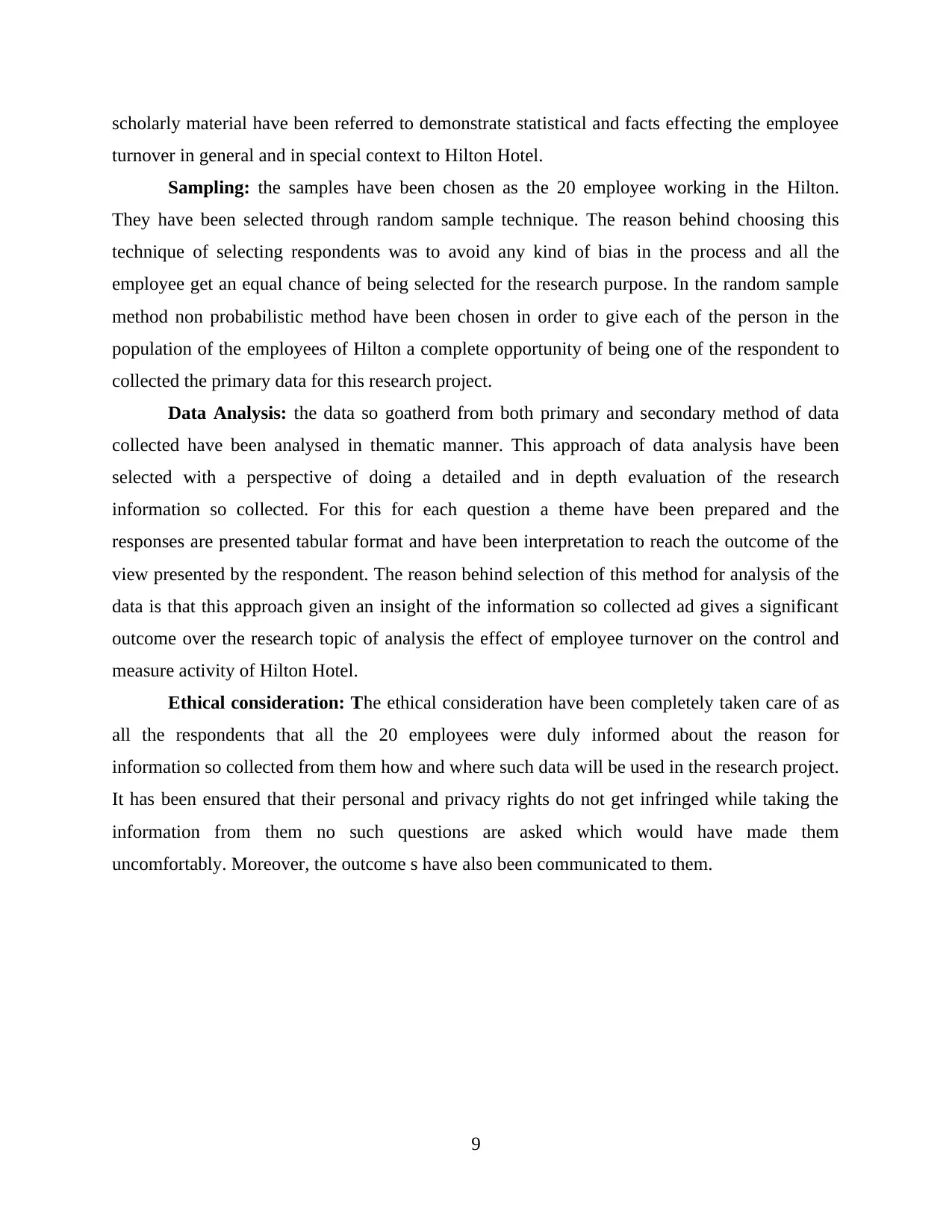
scholarly material have been referred to demonstrate statistical and facts effecting the employee
turnover in general and in special context to Hilton Hotel.
Sampling: the samples have been chosen as the 20 employee working in the Hilton.
They have been selected through random sample technique. The reason behind choosing this
technique of selecting respondents was to avoid any kind of bias in the process and all the
employee get an equal chance of being selected for the research purpose. In the random sample
method non probabilistic method have been chosen in order to give each of the person in the
population of the employees of Hilton a complete opportunity of being one of the respondent to
collected the primary data for this research project.
Data Analysis: the data so goatherd from both primary and secondary method of data
collected have been analysed in thematic manner. This approach of data analysis have been
selected with a perspective of doing a detailed and in depth evaluation of the research
information so collected. For this for each question a theme have been prepared and the
responses are presented tabular format and have been interpretation to reach the outcome of the
view presented by the respondent. The reason behind selection of this method for analysis of the
data is that this approach given an insight of the information so collected ad gives a significant
outcome over the research topic of analysis the effect of employee turnover on the control and
measure activity of Hilton Hotel.
Ethical consideration: The ethical consideration have been completely taken care of as
all the respondents that all the 20 employees were duly informed about the reason for
information so collected from them how and where such data will be used in the research project.
It has been ensured that their personal and privacy rights do not get infringed while taking the
information from them no such questions are asked which would have made them
uncomfortably. Moreover, the outcome s have also been communicated to them.
9
turnover in general and in special context to Hilton Hotel.
Sampling: the samples have been chosen as the 20 employee working in the Hilton.
They have been selected through random sample technique. The reason behind choosing this
technique of selecting respondents was to avoid any kind of bias in the process and all the
employee get an equal chance of being selected for the research purpose. In the random sample
method non probabilistic method have been chosen in order to give each of the person in the
population of the employees of Hilton a complete opportunity of being one of the respondent to
collected the primary data for this research project.
Data Analysis: the data so goatherd from both primary and secondary method of data
collected have been analysed in thematic manner. This approach of data analysis have been
selected with a perspective of doing a detailed and in depth evaluation of the research
information so collected. For this for each question a theme have been prepared and the
responses are presented tabular format and have been interpretation to reach the outcome of the
view presented by the respondent. The reason behind selection of this method for analysis of the
data is that this approach given an insight of the information so collected ad gives a significant
outcome over the research topic of analysis the effect of employee turnover on the control and
measure activity of Hilton Hotel.
Ethical consideration: The ethical consideration have been completely taken care of as
all the respondents that all the 20 employees were duly informed about the reason for
information so collected from them how and where such data will be used in the research project.
It has been ensured that their personal and privacy rights do not get infringed while taking the
information from them no such questions are asked which would have made them
uncomfortably. Moreover, the outcome s have also been communicated to them.
9

CHAPTER 4 DATA COLLECTION
Theme: 1. How long are you working into Hilton hotel?
Particular Respondents
Less than 1 year 5
1-3 year 3
4-5 year 4
More than 5 year 8
Total 20
Figure 2: Working into Hilton hotel
Interpretation:
From the above data, it can be interpreted that more than 5 respondents have been
employed within the hotel for more than 5 years. This may reflect that employees' turnover rate
for the hotel is low. To maintain or control this rate, Hilton hotel may opt for direct feedback and
proper exit interviews for employees who are going to leave the hotel. This may provide it,
sufficient information to assess loopholes within system. The hotel may devise a plan to analyze
the view of current workers regarding organization culture of hotel. Executive supervisors or
leaders may regularly assess strength of organization that need to be increased.
10
Theme: 1. How long are you working into Hilton hotel?
Particular Respondents
Less than 1 year 5
1-3 year 3
4-5 year 4
More than 5 year 8
Total 20
Figure 2: Working into Hilton hotel
Interpretation:
From the above data, it can be interpreted that more than 5 respondents have been
employed within the hotel for more than 5 years. This may reflect that employees' turnover rate
for the hotel is low. To maintain or control this rate, Hilton hotel may opt for direct feedback and
proper exit interviews for employees who are going to leave the hotel. This may provide it,
sufficient information to assess loopholes within system. The hotel may devise a plan to analyze
the view of current workers regarding organization culture of hotel. Executive supervisors or
leaders may regularly assess strength of organization that need to be increased.
10
⊘ This is a preview!⊘
Do you want full access?
Subscribe today to unlock all pages.

Trusted by 1+ million students worldwide
1 out of 26
Related Documents
Your All-in-One AI-Powered Toolkit for Academic Success.
+13062052269
info@desklib.com
Available 24*7 on WhatsApp / Email
![[object Object]](/_next/static/media/star-bottom.7253800d.svg)
Unlock your academic potential
Copyright © 2020–2025 A2Z Services. All Rights Reserved. Developed and managed by ZUCOL.





